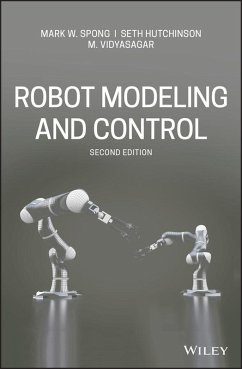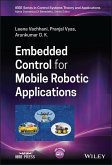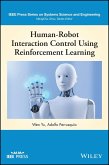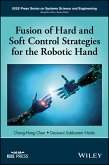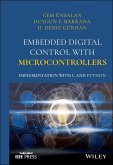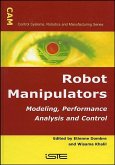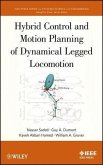

Alle Infos zum eBook verschenken

- Format: ePub
- Merkliste
- Auf die Merkliste
- Bewerten Bewerten
- Teilen
- Produkt teilen
- Produkterinnerung
- Produkterinnerung

Hier können Sie sich einloggen

Bitte loggen Sie sich zunächst in Ihr Kundenkonto ein oder registrieren Sie sich bei bücher.de, um das eBook-Abo tolino select nutzen zu können.
A New Edition Featuring Case Studies and Examples of the Fundamentals of Robot Kinematics, Dynamics, and Control In the 2nd Edition of Robot Modeling and Control, students will cover the theoretical fundamentals and the latest technological advances in robot kinematics. With so much advancement in technology, from robotics to motion planning, society can implement more powerful and dynamic algorithms than ever before. This in-depth reference guide educates readers in four distinct parts; the first two serve as a guide to the fundamentals of robotics and motion control, while the last two dive…mehr
- Geräte: eReader
- mit Kopierschutz
- eBook Hilfe
- Größe: 7.73MB
![Embedded Control for Mobile Robotic Applications (eBook, ePUB) Embedded Control for Mobile Robotic Applications (eBook, ePUB)]() Leena VachhaniEmbedded Control for Mobile Robotic Applications (eBook, ePUB)100,99 €
Leena VachhaniEmbedded Control for Mobile Robotic Applications (eBook, ePUB)100,99 €![The Impact of Automatic Control Research on Industrial Innovation (eBook, ePUB) The Impact of Automatic Control Research on Industrial Innovation (eBook, ePUB)]() The Impact of Automatic Control Research on Industrial Innovation (eBook, ePUB)107,99 €
The Impact of Automatic Control Research on Industrial Innovation (eBook, ePUB)107,99 €![Human-Robot Interaction Control Using Reinforcement Learning (eBook, ePUB) Human-Robot Interaction Control Using Reinforcement Learning (eBook, ePUB)]() Wen YuHuman-Robot Interaction Control Using Reinforcement Learning (eBook, ePUB)118,99 €
Wen YuHuman-Robot Interaction Control Using Reinforcement Learning (eBook, ePUB)118,99 €![Fusion of Hard and Soft Control Strategies for the Robotic Hand (eBook, ePUB) Fusion of Hard and Soft Control Strategies for the Robotic Hand (eBook, ePUB)]() Cheng-Hung ChenFusion of Hard and Soft Control Strategies for the Robotic Hand (eBook, ePUB)118,99 €
Cheng-Hung ChenFusion of Hard and Soft Control Strategies for the Robotic Hand (eBook, ePUB)118,99 €![Embedded Digital Control with Microcontrollers (eBook, ePUB) Embedded Digital Control with Microcontrollers (eBook, ePUB)]() Cem UnsalanEmbedded Digital Control with Microcontrollers (eBook, ePUB)117,99 €
Cem UnsalanEmbedded Digital Control with Microcontrollers (eBook, ePUB)117,99 €![Robot Manipulators (eBook, ePUB) Robot Manipulators (eBook, ePUB)]() Robot Manipulators (eBook, ePUB)266,99 €
Robot Manipulators (eBook, ePUB)266,99 €![Hybrid Control and Motion Planning of Dynamical Legged Locomotion (eBook, ePUB) Hybrid Control and Motion Planning of Dynamical Legged Locomotion (eBook, ePUB)]() Nasser SadatiHybrid Control and Motion Planning of Dynamical Legged Locomotion (eBook, ePUB)98,99 €
Nasser SadatiHybrid Control and Motion Planning of Dynamical Legged Locomotion (eBook, ePUB)98,99 €-
-
-
Dieser Download kann aus rechtlichen Gründen nur mit Rechnungsadresse in A, B, BG, CY, CZ, D, DK, EW, E, FIN, F, GR, HR, H, IRL, I, LT, L, LR, M, NL, PL, P, R, S, SLO, SK ausgeliefert werden.
- Produktdetails
- Verlag: Wiley
- Seitenzahl: 608
- Erscheinungstermin: 25. Februar 2020
- Englisch
- ISBN-13: 9781119524045
- Artikelnr.: 58820545
- Verlag: Wiley
- Seitenzahl: 608
- Erscheinungstermin: 25. Februar 2020
- Englisch
- ISBN-13: 9781119524045
- Artikelnr.: 58820545
- Herstellerkennzeichnung Die Herstellerinformationen sind derzeit nicht verfügbar.
2 221 7.2.1 The Visibility Graph 222 7.2.2 The Generalized Voronoi Diagram 224 7.2.3 Trapezoidal Decompositions 226 7.3 Artificial Potential Fields 229 7.3.1 Artificial Potential Fields for Q =
n 230 7.3.2 Potential Fields for Q
n 235 7.4 Sampling-Based Methods 245 7.4.1 Probabilistic Roadmaps (PRM) 246 7.4.2 Rapidly-Exploring Random Trees (RRTs) 250 7.5 Trajectory Planning 252 7.5.1 Trajectories for Point-to-Point Motion 253 7.5.2 Trajectories for Paths Specified by Via Points 261 7.6 Chapter Summary 263 Problems 265 Notes and References 267 III Control of Manipulators 269 8 Independent Joint Control 271 8.1 Introduction 271 8.2 Actuator Dynamics 273 8.3 Load Dynamics 276 8.4 Independent Joint Model 278 8.5 PID Control 281 8.6 Feedforward Control 288 8.6.1 Trajectory Tracking 289 8.6.2 The Method of Computed Torque 291 8.7 Drive-Train Dynamics 292 8.8 State Space Design 297 8.8.1 State Feedback Control 299 8.8.2 Observers 301 8.9 Chapter Summary 304 Problems 307 Notes and References 309 9 Nonlinear and Multivariable Control 311 9.1 Introduction 311 9.2 PD Control Revisited 313 9.3 Inverse Dynamics 317 9.3.1 Joint Space Inverse Dynamics 317 9.3.2 Task Space Inverse Dynamics 320 9.3.3 Robust Inverse Dynamics 322 9.3.4 Adaptive Inverse Dynamics 327 9.4 Passivity-Based Control 329 9.4.1 Passivity-Based Robust Control 331 9.4.2 Passivity-Based Adaptive Control 332 9.5 Torque Optimization 333 9.6 Chapter Summary 337 Problems 341 Notes and References 343 10 Force Control 345 10.1 Coordinate Frames and Constraints 347 10.1.1 Reciprocal Bases 347 10.1.2 Natural and Artificial Constraints 349 10.2 Network Models and Impedance 351 10.2.1 Impedance Operators 353 10.2.2 Classification of Impedance Operators 354 10.2.3 Thévenin and Norton Equivalents 355 10.3 Task Space Dynamics and Control 355 10.3.1 Impedance Control 356 10.3.2 Hybrid Impedance Control 358 10.4 Chapter Summary 361 Problems 362 Notes and References 364 11 Vision-Based Control 365 11.1 Design Considerations 366 11.1.1 Camera Configuration 366 11.1.2 Image-Based vs. Position-Based Approaches 367 11.2 Computer Vision for Vision-Based Control 368 11.2.1 The Geometry of Image Formation 369 11.2.2 Image Features 373 11.3 Camera Motion and the Interaction Matrix 378 11.4 The Interaction Matrix for Point Features 379 11.4.1 Velocity Relative to a Moving Frame 380 11.4.2 Constructing the Interaction Matrix 381 11.4.3 Properties of the Interaction Matrix for Points 384 11.4.4 The Interaction Matrix for Multiple Points 385 11.5 Image-Based Control Laws 386 11.5.1 Computing Camera Motion 387 11.5.2 Proportional Control Schemes 389 11.5.3 Performance of Image-Based Control Systems 390 11.6 End Effector and Camera Motions 393 11.7 Partitioned Approaches 394 11.8 Motion Perceptibility 397 11.9 Summary 399 Problems 401 Notes and References 405 12 Feedback Linearization 409 12.1 Background 410 12.1.1 Manifolds, Vector Fields, and Distributions 410 12.1.2 The Frobenius Theorem 414 12.2 Feedback Linearization 417 12.3 Single-Input Systems 419 12.4 Multi-Input Systems 429 12.5 Chapter Summary 433 Problems 433 Notes and References 435 IV Control of Underactuated Systems 437 13 Underactuated Robots 439 13.1 Introduction 439 13.2 Modeling 440 13.3 Examples of Underactuated Robots 443 13.3.1 The Cart-Pole System 443 13.3.2 The Acrobot 445 13.3.3 The Pendubot 446 13.3.4 The Reaction-Wheel Pendulum 447 13.4 Equilibria and Linear Controllability 448 13.4.1 Linear Controllability 450 13.5 Partial Feedback Linearization 456 13.5.1 Collocated Partial Feedback Linearization 457 13.5.2 Noncollocated Partial Feedback Linearization 459 13.6 Output Feedback Linearization 461 13.6.1 Computation of the Zero Dynamics 463 13.6.2 Virtual Holonomic Constraints 466 13.7 Passivity-Based Control 466 13.7.1 The Simple Pendulum 467 13.7.2 The Reaction-Wheel Pendulum 471 13.7.3 Swingup and Balance of The Acrobot 473 13.8 Chapter Summary 474 Problems 476 Notes and References 477 14 Mobile Robots 479 14.1 Nonholonomic Constraints 480 14.2 Involutivity and Holonomy 484 14.3 Examples of Nonholonomic Systems 487 14.4 Dynamic Extension 493 14.5 Controllability of Driftless Systems 495 14.6 Motion Planning 499 14.6.1 Conversion to Chained Forms 499 14.6.2 Differential Flatness 506 14.7 Feedback Control of Driftless Systems 509 14.7.1 Stabilizability 509 14.7.2 Nonsmooth Control 511 14.7.3 Trajectory Tracking 513 14.7.4 Feedback Linearization 515 14.8 Chapter Summary 519 Problems 520 Notes and References 521 A Trigonometry 523 A.1 The Two-Argument Arctangent Function 523 A.2 Useful Trigonometric Formulas 523 B Linear Algebra 525 B.1 Vectors 525 B.2 Inner Product Spaces 526 B.3 Matrices 528 B.4 Eigenvalues and Eigenvectors 530 B.5 Differentiation of Vectors 533 B.6 The Matrix Exponential 534 B.7 Lie Groups and Lie Algebras 534 B.8 Matrix Pseudoinverse 536 B.9 Schur Complement 536 B.10 Singular Value Decomposition (SVD) 537 C Lyapunov Stability 539 C.1 Continuity and Differentiability 539 C.2 Vector Fields and Equilibria 541 C.3 Lyapunov Functions 545 C.4 Stability Criteria 545 C.5 Global and Exponential Stability 546 C.6 Stability of Linear Systems 547 C.7 LaSalle's Theorem 548 C.8 Barbalat's Lemma 549 D Optimization 551 D.1 Unconstrained Optimization 551 D.2 Constrained Optimization 552 E Camera Calibration 555 E.1 The Image Plane and the Sensor Array 555 E.2 Extrinsic Camera Parameters 556 E.3 Intrinsic Camera Parameters 557 E.4 Determining the Camera Parameters 557 Bibliography 561 Index 576
2 221 7.2.1 The Visibility Graph 222 7.2.2 The Generalized Voronoi Diagram 224 7.2.3 Trapezoidal Decompositions 226 7.3 Artificial Potential Fields 229 7.3.1 Artificial Potential Fields for Q =
n 230 7.3.2 Potential Fields for Q
n 235 7.4 Sampling-Based Methods 245 7.4.1 Probabilistic Roadmaps (PRM) 246 7.4.2 Rapidly-Exploring Random Trees (RRTs) 250 7.5 Trajectory Planning 252 7.5.1 Trajectories for Point-to-Point Motion 253 7.5.2 Trajectories for Paths Specified by Via Points 261 7.6 Chapter Summary 263 Problems 265 Notes and References 267 III Control of Manipulators 269 8 Independent Joint Control 271 8.1 Introduction 271 8.2 Actuator Dynamics 273 8.3 Load Dynamics 276 8.4 Independent Joint Model 278 8.5 PID Control 281 8.6 Feedforward Control 288 8.6.1 Trajectory Tracking 289 8.6.2 The Method of Computed Torque 291 8.7 Drive-Train Dynamics 292 8.8 State Space Design 297 8.8.1 State Feedback Control 299 8.8.2 Observers 301 8.9 Chapter Summary 304 Problems 307 Notes and References 309 9 Nonlinear and Multivariable Control 311 9.1 Introduction 311 9.2 PD Control Revisited 313 9.3 Inverse Dynamics 317 9.3.1 Joint Space Inverse Dynamics 317 9.3.2 Task Space Inverse Dynamics 320 9.3.3 Robust Inverse Dynamics 322 9.3.4 Adaptive Inverse Dynamics 327 9.4 Passivity-Based Control 329 9.4.1 Passivity-Based Robust Control 331 9.4.2 Passivity-Based Adaptive Control 332 9.5 Torque Optimization 333 9.6 Chapter Summary 337 Problems 341 Notes and References 343 10 Force Control 345 10.1 Coordinate Frames and Constraints 347 10.1.1 Reciprocal Bases 347 10.1.2 Natural and Artificial Constraints 349 10.2 Network Models and Impedance 351 10.2.1 Impedance Operators 353 10.2.2 Classification of Impedance Operators 354 10.2.3 Thévenin and Norton Equivalents 355 10.3 Task Space Dynamics and Control 355 10.3.1 Impedance Control 356 10.3.2 Hybrid Impedance Control 358 10.4 Chapter Summary 361 Problems 362 Notes and References 364 11 Vision-Based Control 365 11.1 Design Considerations 366 11.1.1 Camera Configuration 366 11.1.2 Image-Based vs. Position-Based Approaches 367 11.2 Computer Vision for Vision-Based Control 368 11.2.1 The Geometry of Image Formation 369 11.2.2 Image Features 373 11.3 Camera Motion and the Interaction Matrix 378 11.4 The Interaction Matrix for Point Features 379 11.4.1 Velocity Relative to a Moving Frame 380 11.4.2 Constructing the Interaction Matrix 381 11.4.3 Properties of the Interaction Matrix for Points 384 11.4.4 The Interaction Matrix for Multiple Points 385 11.5 Image-Based Control Laws 386 11.5.1 Computing Camera Motion 387 11.5.2 Proportional Control Schemes 389 11.5.3 Performance of Image-Based Control Systems 390 11.6 End Effector and Camera Motions 393 11.7 Partitioned Approaches 394 11.8 Motion Perceptibility 397 11.9 Summary 399 Problems 401 Notes and References 405 12 Feedback Linearization 409 12.1 Background 410 12.1.1 Manifolds, Vector Fields, and Distributions 410 12.1.2 The Frobenius Theorem 414 12.2 Feedback Linearization 417 12.3 Single-Input Systems 419 12.4 Multi-Input Systems 429 12.5 Chapter Summary 433 Problems 433 Notes and References 435 IV Control of Underactuated Systems 437 13 Underactuated Robots 439 13.1 Introduction 439 13.2 Modeling 440 13.3 Examples of Underactuated Robots 443 13.3.1 The Cart-Pole System 443 13.3.2 The Acrobot 445 13.3.3 The Pendubot 446 13.3.4 The Reaction-Wheel Pendulum 447 13.4 Equilibria and Linear Controllability 448 13.4.1 Linear Controllability 450 13.5 Partial Feedback Linearization 456 13.5.1 Collocated Partial Feedback Linearization 457 13.5.2 Noncollocated Partial Feedback Linearization 459 13.6 Output Feedback Linearization 461 13.6.1 Computation of the Zero Dynamics 463 13.6.2 Virtual Holonomic Constraints 466 13.7 Passivity-Based Control 466 13.7.1 The Simple Pendulum 467 13.7.2 The Reaction-Wheel Pendulum 471 13.7.3 Swingup and Balance of The Acrobot 473 13.8 Chapter Summary 474 Problems 476 Notes and References 477 14 Mobile Robots 479 14.1 Nonholonomic Constraints 480 14.2 Involutivity and Holonomy 484 14.3 Examples of Nonholonomic Systems 487 14.4 Dynamic Extension 493 14.5 Controllability of Driftless Systems 495 14.6 Motion Planning 499 14.6.1 Conversion to Chained Forms 499 14.6.2 Differential Flatness 506 14.7 Feedback Control of Driftless Systems 509 14.7.1 Stabilizability 509 14.7.2 Nonsmooth Control 511 14.7.3 Trajectory Tracking 513 14.7.4 Feedback Linearization 515 14.8 Chapter Summary 519 Problems 520 Notes and References 521 A Trigonometry 523 A.1 The Two-Argument Arctangent Function 523 A.2 Useful Trigonometric Formulas 523 B Linear Algebra 525 B.1 Vectors 525 B.2 Inner Product Spaces 526 B.3 Matrices 528 B.4 Eigenvalues and Eigenvectors 530 B.5 Differentiation of Vectors 533 B.6 The Matrix Exponential 534 B.7 Lie Groups and Lie Algebras 534 B.8 Matrix Pseudoinverse 536 B.9 Schur Complement 536 B.10 Singular Value Decomposition (SVD) 537 C Lyapunov Stability 539 C.1 Continuity and Differentiability 539 C.2 Vector Fields and Equilibria 541 C.3 Lyapunov Functions 545 C.4 Stability Criteria 545 C.5 Global and Exponential Stability 546 C.6 Stability of Linear Systems 547 C.7 LaSalle's Theorem 548 C.8 Barbalat's Lemma 549 D Optimization 551 D.1 Unconstrained Optimization 551 D.2 Constrained Optimization 552 E Camera Calibration 555 E.1 The Image Plane and the Sensor Array 555 E.2 Extrinsic Camera Parameters 556 E.3 Intrinsic Camera Parameters 557 E.4 Determining the Camera Parameters 557 Bibliography 561 Index 576
